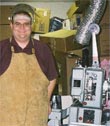|
|
 
|
|
Author
|
Topic: Art House film formats
|
Matt Hale
Expert Film Handler

Posts: 123
From: Vancouver, Canada
Registered: Dec 2002
|
 posted 02-25-2003 12:41 PM
posted 02-25-2003 12:41 PM





Hypothetically speaking, if you were going to open your own single-screen Art House theatre, what formats/gear would you install? And in what priority?
I am thinking the contenders are:
35mm platter
35mm changeover (2000' and/or 6000' reels)
16mm
DLP (or other semi-decent video projection)
You would be showing several different films a week, mostly independent, low-budget, foreign, and even student films, as well as festival screenings, and possibly 1 or 2 first-run features a year.
Also, what sound formats would you install? How about the soundheads? Would you convert to the reverse-scan led type or attempt to fix your broken exciter lamp setup?
Thanks.
| IP: Logged
|
|
Joe Beres
Jedi Master Film Handler

Posts: 606
From: Minneapolis, MN, USA
Registered: Nov 2000
|
 posted 02-25-2003 12:54 PM
posted 02-25-2003 12:54 PM




First and foremost, I would install 35mm. That's what gets people in the seats. Having changeover capability (and even more importantly a capable projectionist) would be enormously beneficial for festival screenings and short runs. You could run automated 6000' reels for longer runs. 16mm would be nice also for other indie and student work. If you have a longer throw and/or a larger screen, you'll probably want a 1k or 2k pedestal projector. If you have a shorter throw and/or a smaller screen, you could get 350w or 550w portable 16mm projectors. (If you have a good amount of money, you could look into getting a Kinoton changeover with one of the two projectors having 16/35 capability.) I prefer Eiki slotloads myself. Video would be a great addition, and in some ways more useful than 16mm. I don't think the cost of DLP is worth it, but a bright projector with a good native resolution would be a great addition to the booth. It would be good to have Beta SP, DVCam/MiniDV, DVD and VHS playback capability.
If you are working with existing equipment, I don't think that LED conversion is a necessity at this point. If you were going to choose a digital system, Dolby SRD readers and the appropriate rack gear would be the way to go. SRD seems to be the most common digital format on foreign and indie films, but digital could be easily done sometime later.
Good luck!
| IP: Logged
|
|
John Pytlak
Film God

Posts: 9987
From: Rochester, NY 14650-1922
Registered: Jan 2000
|
 posted 02-25-2003 01:12 PM
posted 02-25-2003 01:12 PM





Single screen and running a print less than a handful of times usually is best served by changeover projection. For art films, be sure to have lenses and masking to properly show all aspect ratios: 1.37:1, 1.66:1, 1.85:1 and 2.39:1 "scope". If you intend to specialize in silent film or other original formats (e.g., 2.55:1 mag CinemaScope), consider variable speed drive, 3-blade shutters, and ability to shift centerline, in choosing your projectors. Cost of digital projection will depend on screen size and quality expectations, as well as having playback capability for the recording format used. Many theatres RENT digital equipment for particular requirements (e.g., if you need to play a D-5 HD tape) rather than purchase equipment for each format.
| IP: Logged
|
|
|
|
|
|
Scott Norwood
Film God

Posts: 8146
From: Boston, MA. USA (1774.21 miles northeast of Dallas)
Registered: Jun 99
|
 posted 02-25-2003 02:00 PM
posted 02-25-2003 02:00 PM





Don't forget to have a really, really good splicer (Neumade) and rewind bench (Kelmar). Many art-house prints will arrive in terrible condition and will need to be repaired properly before being shown. Many such venues seem to have lousy rewind/inspection facilities, though. A perf-fix machine would be good, too.
Agreed with the others' comments--the equipment minimum should be a 35mm changeover booth with 6000' capability for longer runs. Others will disagree, but I think that 16mm is worthwhile if you can get a good used xenon machine for $5000 or so. Try to get a 16mm machine which can play magnetic tracks (Eikis can). Unless you will be showing mostly repertory titles with mono tracks, a good Dolby sound system (not necessarily digital) is important. A platter might be nice to have, too, for longer runs, but isn't essential if your operator is good and booth space is limited.
Since video equipment keeps getting better and cheaper, I'd take John's suggestion and rent what you need for occasional screenings. If you end up doing a lot of video work (festivals, etc.), then you probably should consider purchasing a medium-grade DLP machine and renting the playback decks. Beta SP seems to be the most popular format for festivals, but the playback hardware starts in the $8000 range. Not to mention that there will be occasional need for Digibeta, DVCAM, 3/4, SVHS, and other formats.
Don't go cheap on lenses. Too many theatres have crappy-looking scope images, which is completely unacceptible. Also, don't think that you will be able to get away without having 1.33 or 1.66 capability--you will need it sooner or later. You aren't likely to need 16mm scope capability, though. ![[Frown]](frown.gif)
If you have extra cash and there is a chance that you will be showing workprints or doing special screenings, consider a DA-88 machine and/or mag dubbers, along with a shaft encoder which can output timecode on the projector motors. Selsyn interlock for 3D would be good, too.
| IP: Logged
|
|
|
|
|
|
|
|
|
|
|
|
|
|
|
|
Matt Hale
Expert Film Handler

Posts: 123
From: Vancouver, Canada
Registered: Dec 2002
|
 posted 02-25-2003 08:40 PM
posted 02-25-2003 08:40 PM





quote:
These days, I suppose Dolby Digital has a lot of marketing leverage on title support as a direct avenue to home video. Do movie productions pay Dolby Labs separate licensing fees for a theatrical release? I wonder about that since most any DVD release requires a new DD encoding at a different bitrate from the theatrical system.
I havent spoken to the front office guys about this for a while, but last I recall, yes, Dobly charged a seperate licence fee for each format and each use, but would usually cut a deal on a "Package" of licences. So if you bought "worldwide theatrical Dolby Digital" + "worldwide theatrial SR" + "North American Home DD" it would be a fair bit cheaper than buying your theatrical rights for realease, then buying home use rights 6 months later when you found out there was demand for home video copies. I can think of several shows that bought the package, only to find they needn't have bothered with the home rights (or the theatrical in some cases)
I think perhaps the term "Underground" would be a better description than Art House of the kind of stuff they're thinking of showing. A good portion of it seems to be produced on Super8. I have yet to figure out how we would ever get Super8 on a 40' screen. Probably couldnt be done - would have to insist on either a video transfer or having it blown up to 16mm. Ugh. We need to have 35mm anyway, so that is a given. I can just picture the booth wall with about 7 port windows in it, and horrible keystoning from the side projectors.
This whole thing is not my idea, I just have to see if I can make it work.
| IP: Logged
|
|
|
|
All times are Central (GMT -6:00)
|
|
Powered by Infopop Corporation
UBB.classicTM
6.3.1.2
The Film-Tech Forums are designed for various members related to the cinema industry to express their opinions, viewpoints and testimonials on various products, services and events based upon speculation, personal knowledge and factual information through use, therefore all views represented here allow no liability upon the publishers of this web site and the owners of said views assume no liability for any ill will resulting from these postings. The posts made here are for educational as well as entertainment purposes and as such anyone viewing this portion of the website must accept these views as statements of the author of that opinion
and agrees to release the authors from any and all liability.
|

 Home
Home
 Products
Products
 Store
Store
 Forum
Forum
 Warehouse
Warehouse
 Contact Us
Contact Us




 Printer-friendly view of this topic
Printer-friendly view of this topic










![[Frown]](frown.gif)

![[Mad]](mad.gif)







